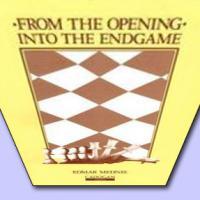
From Opening to Endgame: Petrosian's Triumph
It was the fifth game of the 1963 world championship match between Tigran Petrosian and Mikhail Botvinnik. Petrosian, the challenger, had not yet won a game against Botvinnik, neither in the match nor at any time before. Botvinnik was at +1 in the match, having won the first game while the following three were draws.
Petrosian had not tried to exact revenge for his defeat in the first game. In fact, he had taken the defensive position in the subsequent few games, following his principle that after a defeat one should make a draw. Petrosian understood that after a defeat, negative emotions and desperation could overtake him, leading to a complete collapse. It was necessary to draw a few games and calm down before attempting to level the score. Also, as a debutant in world championship matches, Petrosian needed to get his bearings and gain some confidence. With great difficulty he managed to hold the next few games - had Botvinnik managed to land a second blow, it would have made Petrosian's chances to win the world championship very unlikely. But slowly Petrosian was coming into his own...
The fifth round featured an early queen trade, reaching the following position:
Petrosian had previously analyzed this endgame. During preparations for the match, he had told his second, Isaac Boleslavsky: "If Botvinnik goes into this line, he will lose." A very definitive statement from the supposedly cautious and modest Petrosian!
White has the better structure in this ending - Black has three pawn islands versus White's two. The black e6 pawn is isolated, although it is not on an open file, so it is hard to speak of the pawn as a fatal weakness on its own. Black has a certain amount of activity to compensate for his structural inferiority. The fianchettoed bishop bears down on the white queenside, Black has a potentially valuable queenside majority, and an important role is played by the support square d5. The e6 pawn supports a knight coming to d5; exchanging the knight on d5 is likely not beneficial for White, and playing e3-e4 to cover that square will create a new outpost for Black on d4.
Much depends on whether White can adequately consolidate his position in the next ten to fifteen moves. He needs to arrange his queenside in such a way that he avoids creating targets there - in particular, to remove this pieces from the long diagonal. He needs to control Black's activity around the d5 square. He also needs to trade a few minor pieces, ideally leaving Black with an ineffectual dark-squared bishop, deprived of targets on the long diagonal, against a knight. White also needs to utilize his control of squares in front of the isolated e-pawn, particularly e4, which is a valuable home to a white knight. Achieving these things will leave Black in a passive position with no active counterplay, after which White will be able to carry out operations anywhere on the board.
Black, for his part, needs to create some immediate activity, to change the structure, avoid too much simplification and avoid being pulled into a passive position.
Essentially, I believe that this endgame is a pleasant advantage for White. Black's task is much more difficult than White's. I think going into the endgame was a critical mistake for Botvinnik, which ultimately led to him losing his world championship title. After equalizing the score, Petrosian won again two games later to take the lead in the match. By going into this endgame, Botvinnik allowed Petrosian to continue his safety strategy while still playing for a win. Since consolidation and the slow strengthening of the position were both the route to safety and to the win, Petrosian was able to - in effect - play for two results at once.
Winning the endgame nevertheless required an artistic and instructive technical display, which we will now examine.
RELATED STUDY MATERIAL
- Watch: IM Kiewra's video on similar king marches up the chessboard;
- Watch: The first of our nine-part (!) series on the Grunfeld;
- Examine some of the recent trends in the 4. Nf3 variation - GM Dzindzichashvili's anlaysis and GM Gareev's implementation!

